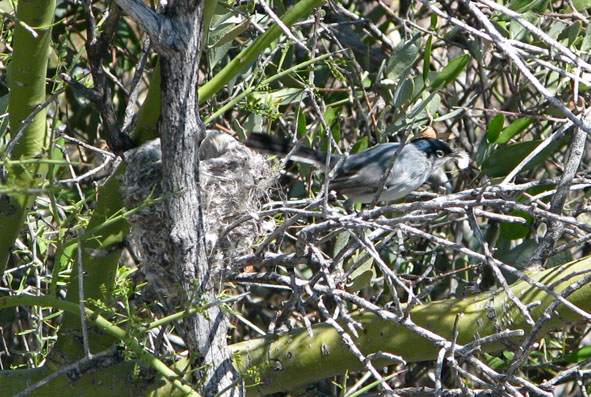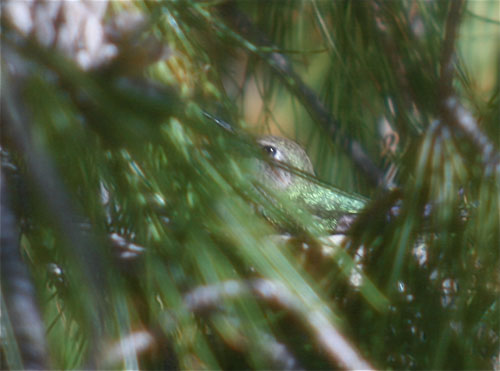Double nidification feature: more Dinky Desert Dudes, plus bonus Hen photo
Not much larger than the Verdin is another small gray bird of the Sonoran Desert, the Black-tailed Gnatcatcher. A tiny, long-tailed, streamlined bird with a narrow gleaning bill, both sexes sport cool gray plumage, and in breeding season the male has a full black cap. They actively forage for insects in desert vegetation, and are almost always found in pairs since they remain with their mate year-round. (The similar Blue-gray gnatcatcher comes through the desert around Phoenix in migration, but Black-tailed gnatcatchers are permanent residents here.) Like the Verdin and hummingbirds, Gnatcatchers are champion nest-builders, and build complex and neatly constructed nests inside thorny trees and shrubs like Palo Verde and Catclaw acacia. (For more detail, see this life history from the Sonoran Desert Museum website)
On a recent desert hike in the Hell’s Canyon Wilderness west of Phoenix, E and I watched a pair of Black-tailed gnatcatchers nesting, repeatedly disappearing into the interior of a Palo verde just off the trail, only about 4 feet from the ground, which is a typical nest location for these tiny birds. In the branches midway to the trunk we could see the oblong cup-shaped nest they were working on.
 They were working on it, but not in the way we first assumed. On closer observation, we realized that although the Gnatcatchers were a nesting pair, they weren’t building the nest we could see — they were robbing from it. Here’s a photo of the male (to the right of the nest) leaving the scene with a bit of white fluff in his beak, on his way to the current construction site somewhere else. A second later, he flew off, but was back for more in less than a minute. The bird and the nest are both very well camouflaged in the gray sticks and twigs spotted with sunlight in the depths of the green-branched Palo Verde tree. (Photo by E. Shock)
They were working on it, but not in the way we first assumed. On closer observation, we realized that although the Gnatcatchers were a nesting pair, they weren’t building the nest we could see — they were robbing from it. Here’s a photo of the male (to the right of the nest) leaving the scene with a bit of white fluff in his beak, on his way to the current construction site somewhere else. A second later, he flew off, but was back for more in less than a minute. The bird and the nest are both very well camouflaged in the gray sticks and twigs spotted with sunlight in the depths of the green-branched Palo Verde tree. (Photo by E. Shock)
And, speaking of camouflage:
Bonus Nidification Challenge — Find the Hen
Obvious hint: look for the bright black eye. Here’s a bonus if blurry photo of the backyard Anna’s hummingbird hen, from an upper window. During the morning the Nid-bough is in the sun, and when the Hen sits on the nest with her back to the hot sunlight, it makes her glow like an emerald in the needles. At times when the sun would strike either eggs or nestlings, her incubating actually provides shade and insulation from overheating, rather than the usual keeping warm of eggs or offspring. A previous successful nest built in the same general area also had the morning sun issue. Every morning, that Hen would stick tight to the nest until shade returned, holding her wings out over the two nestlings under her, the sun beating down on her own head and back.
At times when the sun would strike either eggs or nestlings, her incubating actually provides shade and insulation from overheating, rather than the usual keeping warm of eggs or offspring. A previous successful nest built in the same general area also had the morning sun issue. Every morning, that Hen would stick tight to the nest until shade returned, holding her wings out over the two nestlings under her, the sun beating down on her own head and back.
(Photo A. Shock. The resolution of the photo suffers from being shot through a window screen.)
By now I’ve managed to get a look at the nest from the upper window when the Hen is away, and discovered you can’t see the interior from the angle that view provides. I was hoping to actually see eggs, but no luck…
